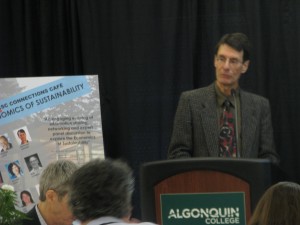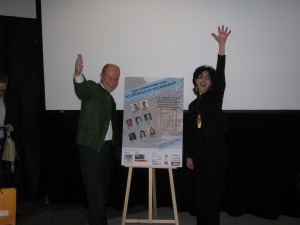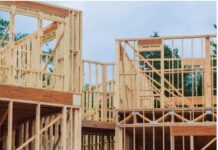Ottawa Construction News staff writer
Can developers and contractors build residential, commercial and institutional structures that combine incredible energy efficiency and work/living quality?
The answer, according to several panelists and speakers at two mid-March events, is “yes”, once hurdles are overcome in the permitting/approval processes, materials supply chain and trades/contractor training.
Seven panelists outlined their successes at the Construction Specifications Canada (CSC) Ottawa Chapter Connections Cafe on the “Economics of Sustainability” at an Algonquin College dinner on March 11. The next day, one of the panelists, Austrian Passive House (PH) guru Gunter Lang, joined Canada’s first PH certified consultant Andrew Peel downtown for presentations about the concept as work commences on the city’s first certified PH project, Salus Clementine, a 42-unit residence for individuals with mental health challenges.
CSV Architects principal Anthony Leaning told the panel discussion that sustainable design and construction does not need to be expensive. His practice has taken on the Salus project, with the learning curve required to design a structure that will use a tiny fraction of the energy required for a conventional building.
“There are social dimensions of sustainable design – design because people matter,” Leaning said. While energy savings can be calculated, the other advantages are harder to measure, including occupant well-being, “social equity through the entire supply chain,” food and material resource security, and local economic benefits.
“These measures can be low cost,” Leaning said. “They create whole communities.”
He described several community and institutional projects, and a suburban commercial building project (he did not name the company). “We designed an open concept work area with lunch space, consolidating work activity in work centres around the space,” he said. The design encouraged more informal interaction and more collaboration.
“The client recorded a 10 per cent improvement in billings,” Leaning said. “When you look at the fixed costs of the building, that’s a very short payback of one or two years.”
Ottawa Salus Corporation executive director Lisa Ker, meanwhile, described her organization’s challenge in creating housing for mentally ill individuals. She says if buildings are designed to healthy standards, they will help the residents’ mental health and integrate them into the wider community. “One of the ways we can achieve that is to have excellent high standards in building maintenance,” she said. “They are active participants in the home and community, and with an investment in themselves, and their health of their home.”
As an added bonus, the upcoming multi-unit Salus Clementine project’s operating costs and ongoing energy bills will be a fraction of conventional structures.
Meanwhile, Adam Cronk, president of Green Giant Design+Build, described some of the challenges he has experienced in constructing buildings to the PH standard.
He observed that the challenge is to demonstrate that sustainable construction can be completed at costs similar to, or even lower, than conventional buildings. He said an average custom home costs about $200 per sq. ft. in Ontario; and tract homes can be constructed for about $125 per sq. ft. The answer, Cronk says, is to move towards prefabricated construction.
“Prefabrication increases efficiency and consistency, while reducing on-site risks and delays,” he said. “When volume goes up, your prices go down.” He says he estimates that in a factory environment, an “insulated air-tight shell on a raft slab, with windows,” could be built for about $75 per sq. ft. “It will be affordable.”
Speaker Nadine Gudz, director, sustainability strategy with global carpet tile manufacturer Interface, took things from a different, international perspective.
She described how her company has taken on the challenge of combining environmental and community sustainability to manufacture carpet/tile products using petroleum and nylon-based source materials that generally would not appear to have much going for them in terms of environmental responsibility.
However, she said Interface founder Ray Anderson decided in 1994 to change the way the business operates, focusing on seven fronts to maintain sustainability: Eliminating waste, ensuring benign emissions, using renewable energy, “closing the loop” on practices; resource-efficient transportation, maintaining a culture of sustainability, and redesigning commerce.
These directions include “ensuring nothing toxic leaves any of Interface’s facilities anywhere in the world. The company has also strived to eliminate dependency on virgin raw materials, among other changes.
Interface discovered a unique way to meet its Nylon-six supply chain requirements, after learning that discarded fishing nets represented about 10 per cent of marine debris, cluttering and polluting oceans and beachfronts around the world.
She said the company arranged with contractors to create local industries in third-world countries to harvest and process the recycled fishing nets, creating sustainable jobs and providing Interface with economical, “100 per cent recycled” materials.

In another discussion, economist and financier Rob Conboy discussed the process of finding the money to finance sustainable projects. Conboy leads Better Building Energy Efficiency (BETTER BEE) in Vermont. “We are a matchmaker,” he said. “We help facilitate relationships between financiers and commercial-scale Passive House projects.”
He says there are convincing arguments for PH/sustainable construction with enhanced cash flow from reduced operating costs. “Better buildings are better able to service debts.”
“There’s a huge track record of just about every type of (PH) building in Europe today,” he said. “We are really emphasizing that while it may be a new technology in North America, it has an enormous track record in Europe.”
He says it is important to build an effective team, with key qualities that include not reinventing the wheel, ensuring that the participants have the correct certification, “finding collaborators who have failed” and (perhaps most challenging), “training the trades”.
“With every new project, we are growing this network of tradespeople who understand they are craftsmen, with pride of work, who are thinking in the longevity of the building.”

The importance of acknowledging and learning from failure should not be underestimated, he said. This speeds the learning process and helps future projects to succeed.
Malcolm Isaacs, who built the first house in Quebec in 2005 to PH standards and is director of the Canadian Passive House Institute (CanPHI), explained the model’s underlying concept and economic advantages.
“In a very mundane way, you can heat a house with a hairdryer, with a heating load of 2 kWh or less,” he said. “That translates, in the heating season, heating cost for your house of less than $200 a year for a detached house, using electric heat.”
“Piped natural gas is even less,” he said. “No conventional furnace, boiler or air conditioner is required.”
“Side benefits include extraordinary comfort, no condensation or mold, extreme climate resilience” – and even in the coldest climates, “a Passive House can never freeze.”

In the question-and-answer session after the presentations, speakers described some of the challenges in adapting the new system.
“There’s a huge resistance in the building industry to any change,” Isaacs said. “You have a lot of vested interests, enormously powerful. Some are valid and some are based on fear.”
One challenge is that there are still very few public PH projects in North America, and until people experience the environment and design, they cannot visualize the concept’s effectiveness and value.
Anthony Leaning, in comparing the PH concept to LEED, said the LEED concept has had a tremendous impact on the North American industry. PH focuses on the results, with specific targets, more than on list of requirements that might have little real sustainable value.
Adam Cronk noted that PH requires much less paperwork than LEED for certification. “There are three basic metrics,” he said. “It doesn’t matter how many bike racks you put outside (for a PH building).
“It’s that simple – if you hit these targets you do it any way you want.”
Before the dinner and speakers’ presentation, 12 sponsoring businesses demonstrated their sustainable products and services in a trade show area, outlining how they can help Ontario projects achieve sustainability standards.
Jeannette Southwood, Global Sustainable Cities leader and infrastructure leader at Golder Associates Ltd. moderated the March 11 discussion.

was the event’s media sponsor.
Several exhibitors said they achieved profitable leads and orders at the event.








